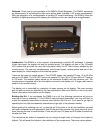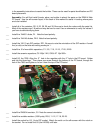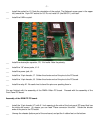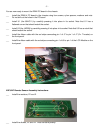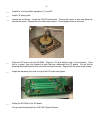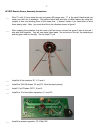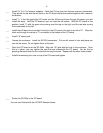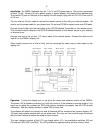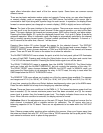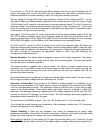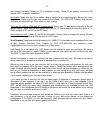
- 11 -
At a minimum, a 100 W HF radio and good 50ohm dummy load can be used to calibrate the HF
sensor and display unit. Even if you know how much power your radio emits, consider using an
additional wattmeter of known accuracy to assist you during the calibration process.
Start by setting R1 through R8 to their center positions. Connect the HF sensor to INPUT 1 on the
main board. Attach a voltmeter between ground and the reverse test point of the HF sensor. Apply
100 W through the HF sensor to a dummy load or resonant antenna; adjust C1 in the HF sensor for
minimum voltage. The minimum reading should be just about 0 Volts. A reading of 0.1 Volt or less
is fine. Be sure the pot for the reverse channel is centered for this adjustment. It is possible to get a
0 Volt reading if the pot is not set correctly.
Again apply 100 W and adjust R1 on the main board so that the forward display reads 100 W. Set
the LCD to display numbers instead of the bargraph. Swap the input and output leads of the HF
sensor and again apply 100 W. Adjust R2 to read 100 W on the reverse display. An error message
(REV>FWD) will appear, but the display is still visible between error-message flashes.
For VHF and UHF, connect a VHF/UHF sensor to one of the other channels. Apply RF power and
adjust the corresponding variable resistor to obtain a correct forward power display. Swap the input
and output leads and repeat for the procedure for reverse power. Repeat the foregoing process for
the other channels by connecting the appropriate sensor to each input and adjusting the
corresponding variable resistors.
Remote Operation: The display head is designed to mount at the station transmitter. The display
unit can be used as table top or under shelf by using the mounting bracket. The mounting bracket
can also be used in a mobile installation.
The remote sensor is supplied with a six-foot cable. The sensor is usually mounted near the
transmitter, but it is possible to mount the remote sensor at the antenna for remote sensing. Be
sure to note that when mounting the sensor at the antenna, the use of an antenna tuner will not
produce the proper readings.
For remote sensing at long distances, a three wire shielded cable must be used. The wire must be
#20 or larger to prevent voltage loss with distances over 100 feet.
Accuracy—a Virtual Bird: The accuracy of the DWM-4 is directly related to its calibration. If you
have an accurate wattmeter or RF power source to which to compare it, the accuracy of the DWM-
4 will be correspondingly precise. The displayed values are derived from a huge look-up table
stored in the microprocessor. These table values were taken from the readings of a Bird 43A
wattmeter. The table was derived by comparing the A/D reading supplied by the HF and VHF/UHF
sensors for various RF readings on the Bird meter. The Bird readings were then graphed and
extrapolated where needed to fill in the gaps.
The resolution of the DWM-4 is about 1 W on the 150 W scale and 0.1 on the 15 watt scale.
Even though the overall accuracy as compared to a Bird wattmeter is better than 0.1%, the actual
accuracy still depends on the calibration.
Trouble Shooting: If there are any problems, first check all components for proper value,
placement and polarity. Next look at the solder connections. Check for cold solder joints and solder
bridges first, since they are the number one cause of problems with the kits.
Does nothing: Check for 12 volts getting to PC board (be sure the switch is on). Check for 5.0 volts
out of 7805 (the left pin). Make sure the 10-pin ribbon cable is installed. Make sure the socket for U1



